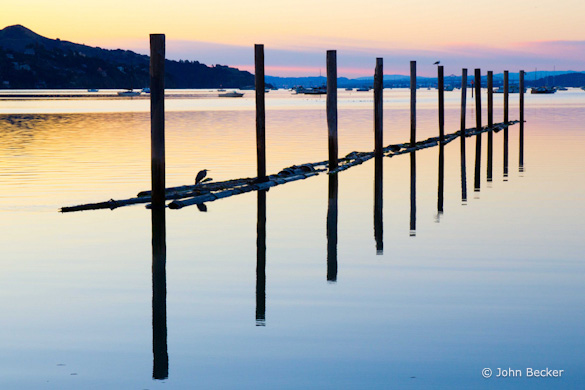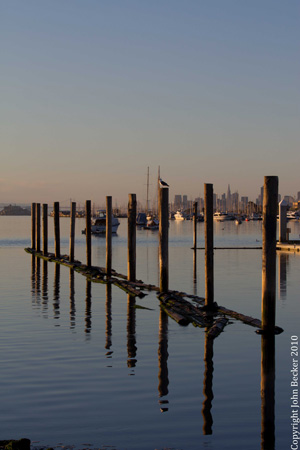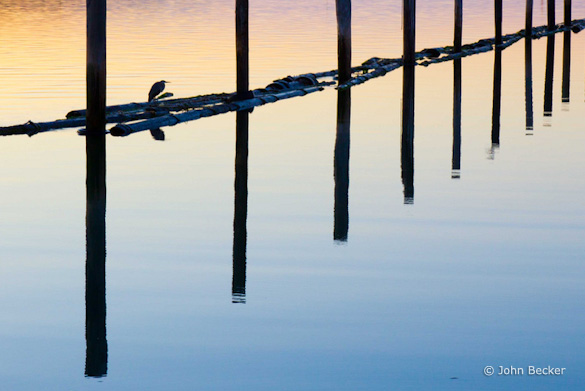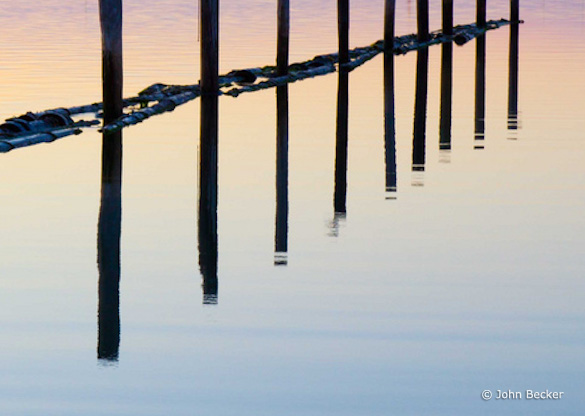
“SunriseSausalito” by John Becker
This week’s photograph was made by John Becker in Sausalito, north of San Francisco. By having his image chosen for this critique Brad will receive a free 16×20 matted print from Aspen Creek Photo. If you’d like your images considered for future critiques you can upload them to the Flickr group I created for this purpose.
The most striking thing about this photograph is the pattern formed by the vertical poles and their reflections. It reminds me of one of my own photographs that I made years ago in another part of San Francisco Bay. These old piers, pilings, and other harbor artifacts can often create interesting designs.

Another composition, made on the same morning, showing San Francisco in the background
John told me that he rose early to drive to this location, and immediately found these posts. He tried various compositions, including some that included the San Francisco skyline in the background (here’s one example), but found too many distractions in that direction. In the end he liked the photograph at the top the best, with the sunrise glow in the sky and without the city skyline.
I certainly agree with this choice. It might have been okay to include San Francisco in the background if there weren’t so many other distractions in that direction—namely all the boats. But what originally attracted John to this scene was the poles and their reflections, not the city. The image at the top, the one John preferred, shows that subject cleanly, with minimal distractions and beautiful light.
The silhouetted heron and gull add nice accents—especially that heron, which is perfectly positioned within the frame. It seems like a small thing, but I don’t think I’d like this photograph nearly as much without the birds. I also love how the reflections of the poles look like they’ve been sliced into little pieces near their tips.
By excluding the San Francisco skyline, John avoided a common photographic disease called “Adding On.” This virus infects photographers when they find an interesting subject or scene, but then say, “Oh, look at that—that’s interesting too. Oh, and I like that also. I wonder if I can fit all those things together in one photograph.” The resulting composition becomes cluttered, and the original idea—the inspiration for the photograph—gets lost and forgotten.
The cure is obvious—stick to the original idea. Ask yourself what caught your eye in the first place, then find a way to show that to it’s best advantage. And make your answer to this questions as precise as possible. In other words, instead of saying, “That tree,” say “The shapes of those branches,” or “The color of the moss on the trunk,” or “The way the light is shining through those leaves.”
John did the first part of that process well here. He was most interested in the poles and their reflections, so he concentrated on those, and resisted the temptation—at least for some images—to include the San Francisco skyline in the background. He found a nice balanced arrangement of the poles and reflections that included the birds and the nice pastel colors.
But there is still some background clutter in the top part of the frame. The distant boats and hills break up the clean lines of the poles and detract from power of all that repetition. Of course it’s hard to find a solution for this; to include the tops of the poles without also including the hills and boats would have required a higher vantage point, something that I assume wasn’t available.
But perhaps John could have gone further and asked himself what it was about those poles and reflections that attracted him. I can’t answer that question for him, but for me it’s the lines and patterns created by those poles and their reflections. I could add other things, like the birds, and the reflections of those pole tips, but they’re not essential.
If you say it’s the poles and their reflections that are most interesting, then there’s no way to avoid the background clutter because you have to include each pole in its entirety. But if you say it’s the lines and patterns that are most captivating, then it becomes possible to show those, without including the boats and hills, by cutting off the tops of the poles. I’ve included a couple of crops that do just that.
Is it worth losing the tops of those poles, and the symmetry and balance they provide, to eliminate the background clutter? I think so, but I’m not sure—I’d have to live with these variations for awhile before making a final decision. The cropped versions are more abstract, which will appeal to some people more than others. The lack of a horizon is also somewhat disorienting, which could be intriguing or confusing, depending on your point of view. As always, I’d love to hear your opinions about this.
But regardless of which version you prefer, my point is that when you’re behind the camera you’ll create more options for yourself if you can be as specific as possible about what attracted you to a scene in the first place. By doing so you may find alternate compositions and approaches and that you wouldn’t have thought of otherwise.
Technically this photograph is well executed—the exposure looks perfect, everything appears to be in focus, and the contrast looks about right. John mentioned that he thought he added a bit too much saturation in this version he posted on Flickr, and in later versions backed off a bit. I’ll concur with that; it’s a fine line, but my first impression was that the saturation was a bit too high and unnatural looking.
An intriguing side note to this image is that John made it just after taking a two-day private workshop in Yosemite with my friend Mike Osborne. John rose early and went to Sausalito to try to take what he had learned from Mike and “do it on my own.” Mike is an excellent teacher who has assisted me in many workshops, and it looks like John learned his lessons well. (For what it’s worth, I didn’t know about this story until after I picked this image for the critique—John does not even have his last name on Flickr, nor would I have recognized it if he did.) Of course I also teach private workshops in Yosemite through The Ansel Adams Gallery.
Thanks John for sharing your image!
As part of being chosen for this week’s critique John will receive a free 16×20 matted print courtesy of the folks at Aspen Creek Photo. If you’d like your images considered for future critiques, just upload them to the Flickr group I created for this purpose. If you’re not a Flickr member yet, joining is free and easy. You’ll have to read and accept the rules for the group before adding images, and please, no more than five photos per person per week. I’ll be posting the next critique in two weeks. Thanks for participating!










